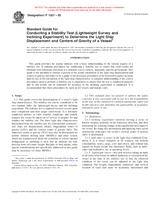We need your consent to use the individual data so that you can see information about your interests, among other things. Click "OK" to give your consent.
ASTM F1321-92
Standard Guide for Conducting a Stability Test (Lightweight Survey and Inclining Experiment) to Determine the Light Ship Displacement and Centers of Gravity of a Vessel
STANDARD published on 1.1.1992
The information about the standard:
Designation standards: ASTM F1321-92
Note: WITHDRAWN
Publication date standards: 1.1.1992
SKU: NS-49891
The number of pages: 28
Approximate weight : 84 g (0.19 lbs)
Country: American technical standard
Category: Technical standards ASTM
Annotation of standard text ASTM F1321-92 :
Keywords:
Angle of inclination, Center of gravity, Displacement, Draft, Equilibrium heel angle, Inclining experiment, Light ship displacement, Marine (shipboard) systems/subsystems/equipment, Metacenter, Mooring, Pendulum test, Shipbuilding materials-general, Stability, Tankage, conducting a stability test (lightweight survey and inclining, experiment) to determine the light ship displacement and centers of, gravity of a vessel, guide,, United States Coast Guard (USCG)
Additional information
| 1. Scope | ||
|
1.1 This guide covers the determination of a vessel's light ship characteristics. The stability test can be considered to be two separate tasks; the lightweight survey and the inclining experiment. The stability test is required for most vessels upon their completion and after major conversions. It is normally conducted inshore in calm weather conditions and usually requires the vessel be taken out of service to prepare for and conduct the stability test. The three light ship characteristics determined from the stability test for conventional (symmetrical) ships are displacement (displ), longitudinal center of gravity (LCG), and the vertical center of gravity (KG). The transverse center of gravity (TCG) may also be determined for mobile offshore drilling units (MODUs) and other vessels which are asymmetrical about the centerline or whose internal arrangement or outfitting is such that an inherent list may develop from off-center weight. Because of their nature, other special considerations not specifically addressed in this guide may be necessary for some MODUs. 1.2 This standard does not purport to address the safety problems, if any, associated with its use. It is the responsibility of the user of this standard to establish appropriate safety and health practices and determine the applicability of regulatory limitations prior to use. |
||
| 2. Referenced Documents | ||
|
We recommend:
Technical standards updating
Do you want to make sure you use only the valid technical standards?
We can offer you a solution which will provide you a monthly overview concerning the updating of standards which you use.
Would you like to know more? Look at this page.




 Cookies
Cookies
